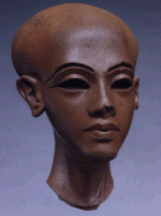
Pt. I - Ankhesenpaaten

The King and Queen of Egypt were in transition. They were either in the process or had just completed the move from Malkata to the new palaces in Akhet-Aten, the new capital of Egypt. The young king, Amenhotep IV, was changing his name to honor his God -- he would henceforth be known as Neferkheperure-Wa'enre Akhenaten. The King was abandoning the old gods of Egypt, in favor a Aten, a minor sun-god who was the physical Sun Disk. The King particularly hated Amun, the King of the Gods, and the greedy priesthood thereof, centered in Waset (Thebes). The queen, the beautiful Nefertiti, would have the appellation Neferneferuaten added to her name; she was also pregnant with the royal couple's third child.
They already had two daughters: the much-much loved princesses Meritaten (called "Mayati") and Meketaten. The girls were active children: Mayati was about five years old, Meketaten was probably about three or four, but her exact birth year is not clear. Everyone hoped that Akhenaten and Nefertiti's third child would be a son, a prince -- an heir.
Some time in Regnal Year 5 or 6, in Malkata or even Akhet-Aten, the third child of the King and Queen of Egypt was born. Another girl: Ankhesenpaaten (AHNK-es-en-pa-AH-ten, "She Lives Through the Aten" or "Living Through the Aten") was born. The Prince Smenkhkare, a younger brother or even son (by a minor wife, possibly Kiya) of Akhenaten, was still the heir.
The three eldest girls -- Meritaten, Meketaten, and Ankhesenpaaten -- were the "Senior Princesses;" as each was born she accompanied her parents in various statues and reliefs around the new city. All of the girls were treasured, but Meritaten -- Mayati -- as the eldest, seems to have been the family favorite. By year 12 (or even as early as year 10) they had been joined by three "Junior Princesses," Nefernefruaten ta-Sherit (named after Nefertiti), Nefernefrure, and Setepenre. These girls are less visible then their elder sisters, and appear only in tombs of nobles and in decorations in the palace -- the elder three were portrayed all over Akhet-Aten. Also in this time, another prince makes an appearance. During the years 7-9, little Prince Tutankhaten was born. He is closely related to Smenkhkare, and was probably a brother or half-brother of the elder prince. Tutankhaten's parents were possibly Akhenaten and Kiya, but there are other theories as well.
Ankhesenpaaten would have grown up in the nursery, probably learning to read and write (although women, even royal women, were not often literate, evidence exists that suggests the Amarna Princesses were), and even painting -- dabs of color were found on the walls of the nursery in the palace, suggesting the six little princesses were encouraged to express their creativity by painting on the walls -- the marks are clearly the dabblings of young children. Her closest companions would have been her sisters, the two young princes (whoever their parents were) and her nurse -- menat, in Egyptian -- the lady Tia. Tia has the distinction of being the only menat of the Amarna princesses who name is known. A talatat block exists that names her as "Nurse of the King's Daughter, Ankhesenpaaten, Tia."
In Regnal Year 12, when Princess Ankhesenpaaten was about six or seven, there was a great festival in Akhet-Aten. Gifts and tribute were brought to Pharaoh from far and wide -- a plague may have also come with them. By year fourteen, Meketaten had died, Setepenre, Neferneferure (and possibly Nefernefruaten ta-Sherit) had ceased to be mentioned. The King's Mother Tiye, the Great Royal Wife Nefertiti, and the King's Favorite Kiya have also ceased to be mentioned. The only members of the Royal Family we can say with confidence at the time were still alive was the King, Akhenaten, the two princes, Smenkhkare and Tutankhaten, and Akhenaten's first and third daughters, Meritaten and Ankhesenpaaten.
Meketaten may have died in childbirth. If this was the case, Akhenaten was probably the father. If Meketaten, the second daughter, had died giving birth to her father's child (remember, this was not taboo in ancient Egyptian royal families, as repugnant as it may seem today, close family marriages were common -- but ONLY in the royal family), it stands to reason that Meritaten would have been elevated to a Royal Wife of Akhenaten as well. The mysterious princess Meritaten ta-Sherit may be a daughter of this union. In about year fifteen or sixteen, Akhenaten took Ankhesenpaaten (who was about 10 years old) as his wife, and the problematic princess Ankhesenpaaten ta-Sherit may have been the daughter of Ankhesenpaaten and her father. However, the "ta-Sherits" are only mentioned a few times, and their parentages are not clear.
The later years of Akhenaten's year are full of mysteries, and since this is focused on Princess Ankhesenpaaten, we will not get into all of them here. Ankhesenpaaten may have been the Great Royal Wife of Akhenaten and/or Smenkhkare (co-regent of Akhenaten) briefly, before she was thirteen years old. Her true life as a queen of Egypt did not begin however, until the deaths of Akhenaten and his co-regent. The twelve or thirteen-year-old princess was the member of the royal family left; well, there was one other, but he was a child of Pharaoh and a minor wife, only "half-royal," but he was the only male heir. The young Princess Ankhesenpaaten and the little Prince Tutankhaten (aged about nine) were married. And thus began the reign of the legendary boy-king.
Continue to Pt. II - Ankhesenamen